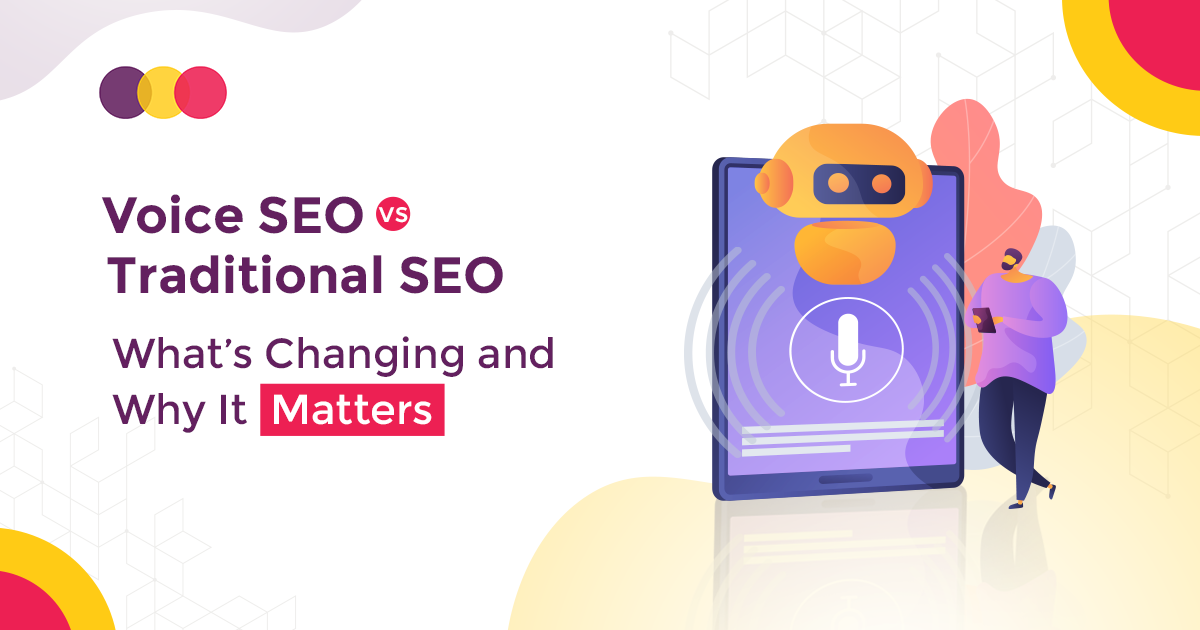In the ever-evolving world of digital marketing, SEO is far from static. As technology continues to reshape how people search, one trend is making a massive impact on Voice SEO. With virtual assistants like Siri, Alexa, and Google Assistant becoming part of daily life, users are no longer just typing their queries; they’re speaking them.
This shift is changing how businesses should think about search optimization. So, what exactly is Voice SEO, how does it differ from Traditional SEO, and why does it matter so much in 2025? Let’s break it down.
1. What Is Voice SEO?
Voice SEO is the process of optimizing your website and content to appear in voice search results. Instead of typing, users now ask voice assistants questions like:
- “Hey Google, where’s the best embroidery shop near me?”
- “Alexa, what’s the fastest way to grow my business online?”
Voice SEO focuses on conversational, natural language and question-based queries, often providing a single spoken answer instead of a list of search results.
In short, traditional SEO wins the screen, while voice SEO wins the conversation.
2. How Traditional SEO Works
Traditional SEO revolves around optimizing web pages to rank higher on search engine results pages (SERPs). It includes factors such as:
- Keyword optimization
- Backlinks and domain authority
- Technical SEO (site speed, mobile responsiveness, etc.)
- Meta tags and structured content
The goal is to get users to click on your website from the list of links Google displays. It’s about visibility and clicks; you want your page to stand out visually and contextually.
3. The Key Differences Between Voice SEO and Traditional SEO
While both aim to make your brand more discoverable, the approach and user behavior differ significantly. Let’s look at the main differences:
| Aspect | Traditional SEO | Voice SEO |
|---|---|---|
| Search Type | Typed queries | Spoken queries |
| Query Style | Short, keyword-based (“best digital marketing agency”) | Conversational (“Who is the best digital marketing agency near me?”) |
| Results Format | Multiple listings on a page | Usually one spoken result (featured snippet) |
| Optimization Focus | Keywords, backlinks, meta data | Conversational content, featured snippets, local SEO |
| Devices | Desktops, mobile browsers | Smart speakers, mobile voice assistants |
| User Intent | Informational or transactional | Quick, direct answers |
Voice SEO is all about natural speech patterns, meaning your content must sound the way people talk, not just how they type.
4. Why Voice Search Is Growing So Fast
According to recent studies, over 50% of all online searches are now voice-based, and that number continues to rise. The reasons are simple:
- Convenience: Speaking is faster than typing.
- Hands-free interaction: Perfect for multitasking.
- Smart devices: The rise of Alexa, Google Nest, and Siri means more people rely on voice.
Consumers are now asking voice assistants to find local businesses, make calls, or even order products. For brands, this means voice search is no longer optional, it’s essential.
5. Why Voice SEO Matters for Businesses in 2025
The voice search revolution is more than a tech trend, it’s a shift in consumer behavior. Here’s why it matters:
a. Voice Search Drives Local Results
Most voice searches have local intent, for example, “Where’s the nearest cafe?” or “Find a digital agency near me.”
If your business isn’t optimized for local SEO (Google Business Profile, location keywords, and reviews), you’re missing out on real leads.
b. Featured Snippets Win the Voice Race
Voice assistants often retrieve answers from featured snippets, the highlighted boxes you see at the top of Google search results.
Creating clear, concise, and answer-driven content increases your chances of being that “one spoken answer.”
c. Conversational Search Is the New Normal
People now talk to their devices like humans, not search engines.
Optimizing for long-tail and question-based keywords (“how,” “what,” “where”) helps your content match these conversational tones.
d. Competitive Edge
While many businesses are still stuck in traditional SEO strategies, early adopters of Voice SEO can dominate niche markets, especially local and service-based ones.
6. How to Optimize for Voice SEO
Now that we know why it’s important, here’s how to prepare your business for the voice era:
1. Use Natural, Conversational Language
Write content that sounds like a real conversation. Instead of “digital marketing strategies 2025,” use “What are the best digital marketing strategies for 2025?”
2. Focus on Long-Tail & Question Keywords
Use tools like Google’s “People Also Ask” or AnswerThePublic to find the questions your audience is asking.
3. Optimize for Local Search
Claim and optimize your Google Business Profile, include your location in metadata, and use “near me” phrases where relevant.
4. Create FAQ Sections
FAQs are perfect for voice search; they naturally contain question-answer structures that smart assistants love.
5. Improve Site Speed and Mobile Responsiveness
Voice searches often come from mobile devices. A slow or non-responsive site can kill your chances of ranking.
6. Target Featured Snippets
Use structured data (schema markup) and provide concise, 40–50 word answers to common questions.
7. The Future of SEO: Blending Voice and Traditional
The truth is, Voice SEO won’t replace Traditional SEO, it complements it. The future of digital visibility lies in balancing both:
- Use traditional SEO for depth, backlinks, and long-form content.
- Use voice SEO for accessibility, local reach, and direct answers.
Together, they create a powerful ecosystem that covers both typed and spoken intent, helping your brand stay visible, relevant, and discoverable everywhere.
8. Conclusion
The shift from traditional search to voice search represents more than a technology upgrade; it’s a transformation in how people connect with information.
Voice SEO is about understanding human behavior, how we speak, what we ask, and what we expect. As AI-driven assistants become more integrated into our lives, optimizing for voice will soon become as essential as optimizing for keywords once was.
So, if your business wants to stay ahead in 2025, it’s time to speak your strategy literally.






